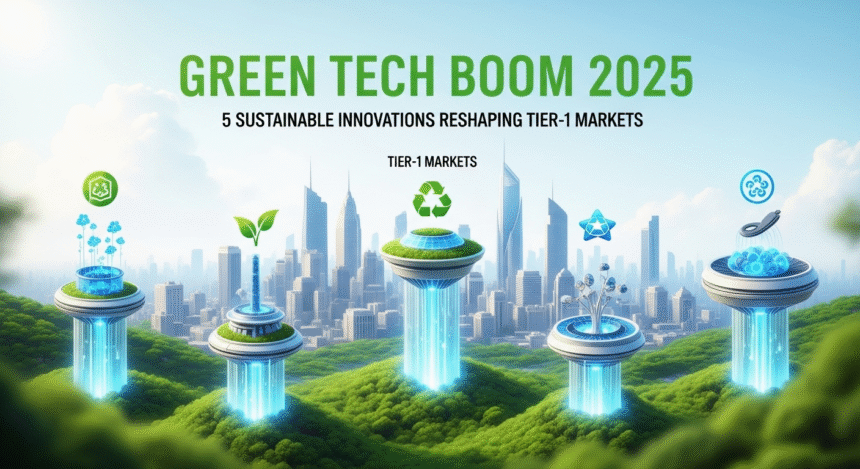Introduction: Sustainability as a Strategic Imperative
Climate change has shifted from being a looming concern to a present-day business challenge — and opportunity. In 2025, Tier-1 markets such as the United States, United Kingdom, Canada, Germany, and Australia have made sustainability a non-negotiable standard rather than a branding option.
Regulators, investors, and consumers now demand greener solutions, while technology companies — from agile startups to global giants — are racing to lead this transformation. The winning formula? Merging sustainability with profitability.
This article explores five of the most impactful green tech innovations shaping Tier-1 economies in 2025—developments that are not only reducing environmental footprints but also driving new revenue opportunities.
1. Solar-Powered Consumer Electronics
1.1 Everyday Gadgets Go Solar
Solar integration has expanded beyond rooftops. Today, solar-powered chargers, laptops, wearables, and even headphones are mainstream in Tier-1 markets. These products reduce dependence on fossil-fuel-driven grids and give consumers the power — literally — to generate energy wherever they are.
1.2 U.S. Startup Scaling the Sector
A California-based startup specializing in portable solar chargers achieved 300% year-over-year growth by targeting remote workers, travelers, and eco-conscious consumers. Their products helped cut grid reliance while creating a profitable, fast-scaling niche in consumer electronics.
2. Smart Home Energy Management Systems
2.1 Homes That Think for Themselves
Smart homes have evolved from passive energy-saving appliances to intelligent energy orchestration systems. AI-powered hubs now monitor heating, cooling, lighting, and power use in real time, recommending adjustments that lower both costs and emissions.
2.2 UK Energy Campaign Success
In the UK, a nationwide rollout of smart meters combined with AI-driven optimization tools led to an average 18% drop in household energy consumption, proving that broad adoption of green tech can move the needle at scale.
3. Electric Vehicle (EV) Charging Innovations
3.1 The Ultra-Fast Charging Era
As EV adoption accelerates, slow charging remains one of the biggest consumer barriers. Tier-1 governments are investing in ultra-fast charging stations (up to 350kW) that can power cars in minutes, not hours — making EV ownership far more practical.
3.2 Canada’s National EV Rollout
Canada’s highway fast-charger program, rolled out nationwide, enables drivers to refuel their EVs in under 15 minutes. This advancement has directly supported higher adoption rates and positioned the country as a leader in clean mobility infrastructure.
4. Recyclable & Modular Electronics
4.1 Tackling the E-Waste Crisis
With e-waste reaching record levels, companies in Tier-1 markets are embracing design-for-recycling principles. Modular devices — where consumers can replace or upgrade components individually — are extending product lifespans and reducing toxic landfill waste.
4.2 Germany’s Modular Smartphone Model
A Berlin-based company’s fully modular smartphone has gained traction across Europe. Users can swap batteries, cameras, and screens without replacing the entire device — extending its lifecycle by several years and significantly reducing waste.
5. AI-Driven Sustainability
5.1 From Data to Energy Efficiency
AI is powering the next generation of sustainability gains, optimizing everything from household consumption to large-scale industrial operations. Algorithms analyze usage trends, predict demand spikes, and automatically balance loads to cut unnecessary energy use.
5.2 Australian Mining Innovation
In Australia, an AI-powered mining system reduced diesel consumption by 14% by intelligently adjusting machine operations. This demonstrates how even traditionally high-carbon industries can achieve meaningful reductions when paired with advanced tech.
Conclusion: Green Technology as an Engine of Growth
In Tier-1 markets, sustainability has become a competitive advantage, not just a moral obligation. Companies leveraging green tech are:
- Winning eco-conscious customers
- Cutting operational costs
- Reducing regulatory risk
- Building lasting brand trust
The surge of solar-powered devices, smart energy systems, EV charging innovations, modular electronics, and AI-driven optimization is laying the foundation for a cleaner, more resilient economy.
In 2025, going green isn’t just about saving the planet — it’s about powering the next wave of profitable innovation.





